1. i. 2CH3CH2CHOΘOH−−→(A)Δ−−→(B)
ii. 2PhCH2CHOΘOH−−→(C)Δ−−→(d)
iii. ![1. i. 2CH(3)CH(2)CHOoverset(Θ)overset(OH)rarr(A)oversetDeltararr(B) ii. 2PhCH(2)CHOoverset(Θ)overset(OH)rarr(C)oversetDeltararr(d) iii. iv. 2. i. ii. A hydrocarbon (A) of the formula C(7)H(12) on ozonolysis gives a compound (B) which undergoes aldol condensation giving 1-acetyI cyclopentene. Identify (A) and (B). 3. Acetone and butan-2-one undergo both self and across aldol (ketol) condensations to gove aldol (ketol) which loses water to give alpha,beta- unsaturated ketones. The number of isomeric alpha,beta- unsaturated ketones formed is: i. Three iii. Four ii. Five iv. Six 4. Give the cyclic intramolecular aldol condensation of the following reactions: a. Hexane-2,5-dione underset((ii) Delta)overset((i)overset(Θ)(O)H)rarr b. Octane-2,8-dione underset((ii) Delta)overset((i)overset(Θ)(O)H)rarr c. Nonane-2,8-dione underset((ii) Delta)overset((i)overset(Θ)(O)H)rarr d. Pentane-2,4-dione underset((ii) Delta)overset((i)overset(Θ)(O)H)rarr 5. Identify the reactants that can be and that cannot be synthesised from the compounds given below. i. PhCH=CHCOCH=CHPh ii. PhCH=CHCH(2)COMe iii. PhCH=CHCH(2)CH(2)COMe iv. PhCOCH=CH(2) v. PhCH=CHCH=CHCOMe vi. 3- Ethyl -2- methyl cyclohex -2-en-one vii. 2- Methyl cyclohex -1-ene-carboxaldehyde viii. ix. 1- Hydroxy-4-methyl bicyclo [2.2.2] octan-3-one 6. Give the mixed aldol product from the reaction of crotonaldehyde (CH(3)CH=CH-CH=O) with CH(3)CHO](https://d10lpgp6xz60nq.cloudfront.net/physics_images/KSV_CHM_ORG_P2_C13_S01_014_Q01.png)
iv. 
2. i. 
ii. A hydrocarbon (A) of the formula C7H12 on ozonolysis gives a compound (B) which undergoes aldol condensation giving 1−acetyI cyclopentene. Identify (A) and (B).
3. Acetone and butan−2-one undergo both self and across aldol (ketol) condensations to gove aldol (ketol) which loses water to give α,β− unsaturated ketones. The number of isomeric α,β− unsaturated ketones formed is:
i. Three
iii. Four
ii. Five
iv. Six
4. Give the cyclic intramolecular aldol condensation of the following reactions:
a. Hexane−2,5−dione (i)ΘOH−−−−→(ii)Δ
b. Octane−2,8−dione (i)ΘOH−−−−→(ii)Δ
c. Nonane−2,8−dione (i)ΘOH−−−−→(ii)Δ
d. Pentane−2,4−dione (i)ΘOH−−−−→(ii)Δ
5. Identify the reactants that can be and that cannot be synthesised from the compounds given below.
i. PhCH=CHCOCH=CHPh
ii. PhCH=CHCH2COMe
iii. PhCH=CHCH2CH2COMe
iv. PhCOCH=CH2
v. PhCH=CHCH=CHCOMe
vi. 3− Ethyl −2− methyl cyclohex −2−en-one
vii. 2− Methyl cyclohex −1−ene-carboxaldehyde
viii. 
ix. 1− Hydroxy−4−methyl bicyclo [2.2.2] octan−3−one
6. Give the mixed aldol product from the reaction of crotonaldehyde (CH3CH=CH−CH=O) with CH3CHO
1. i. 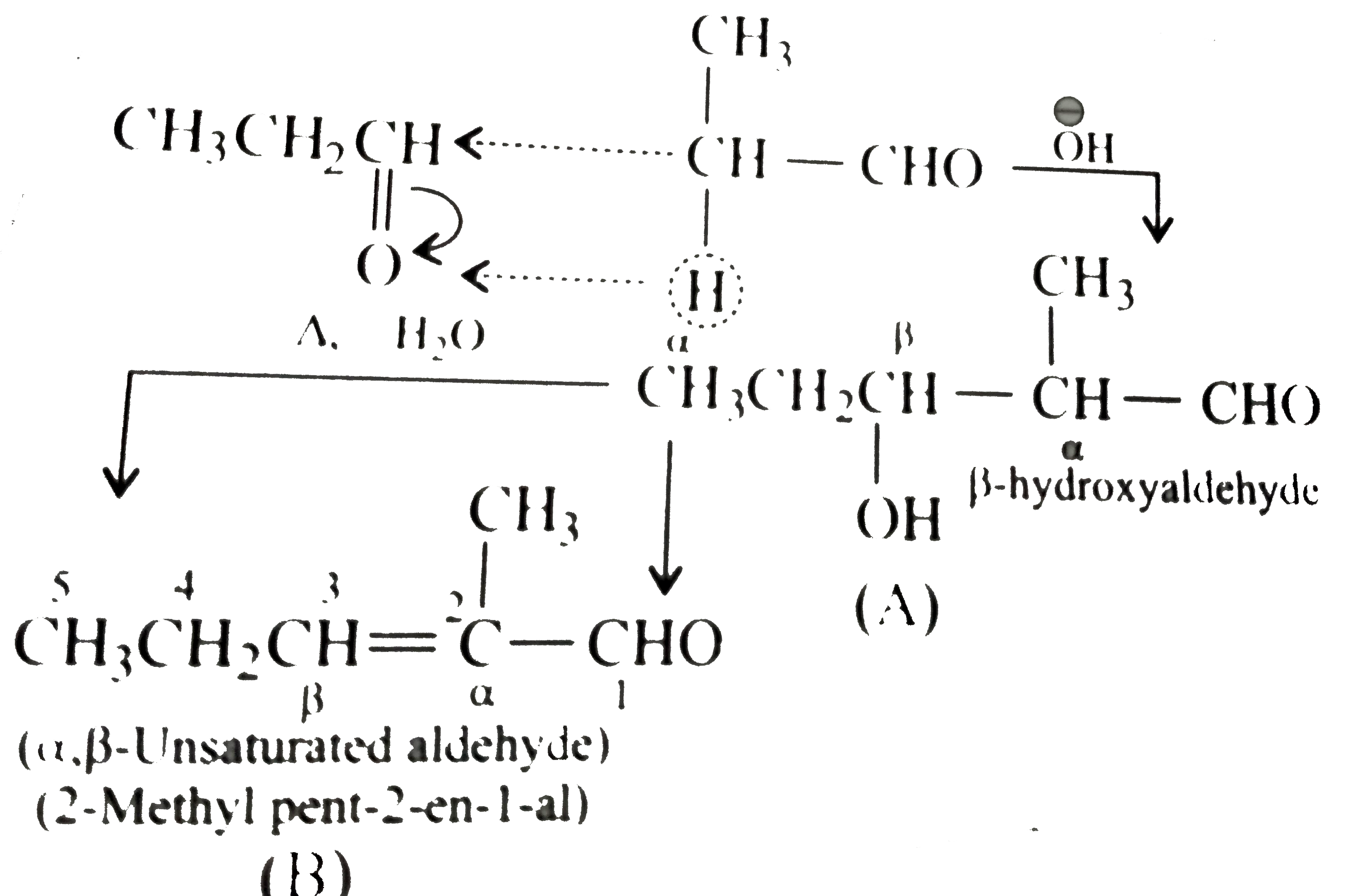
ii. 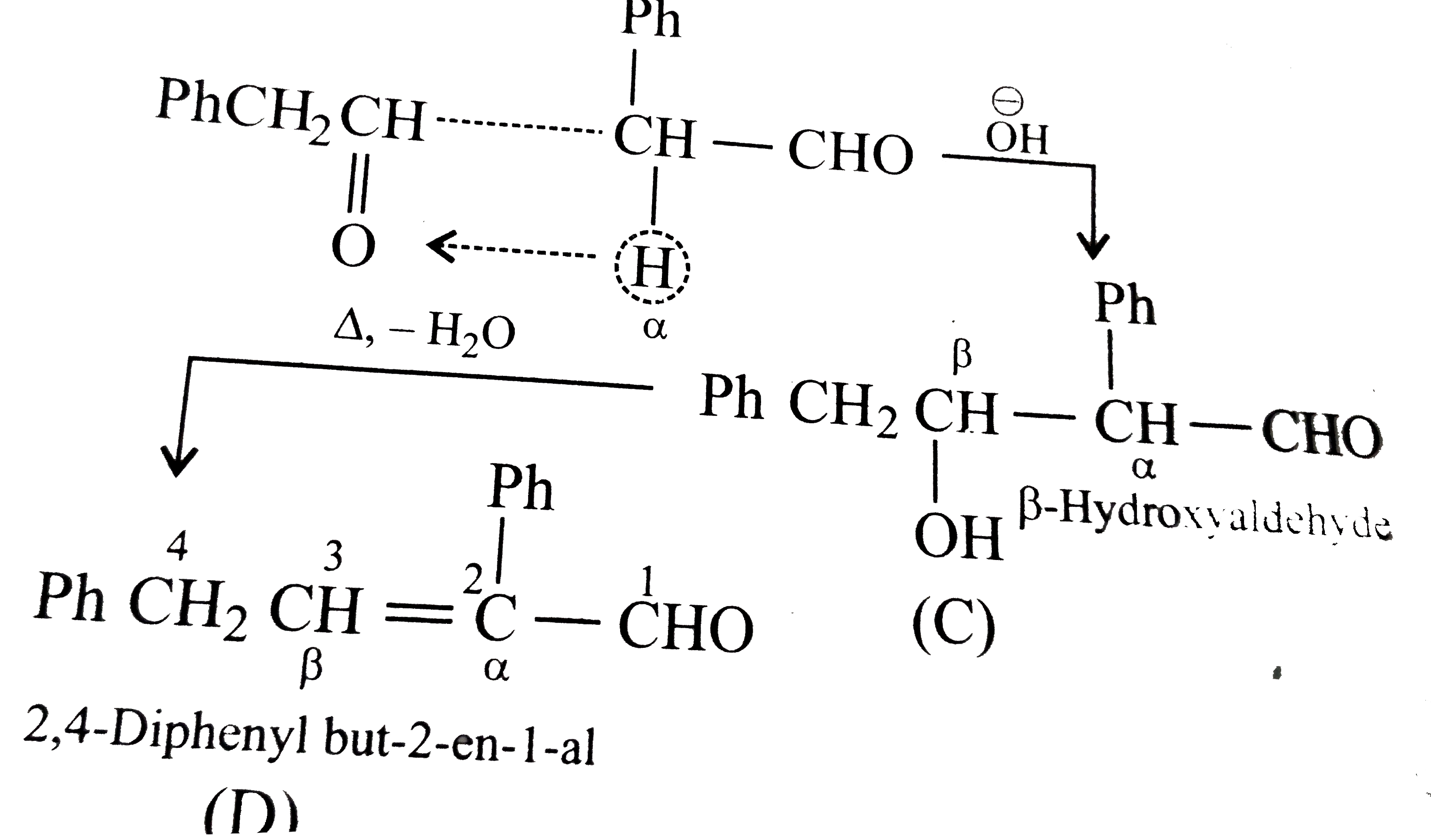
iii. 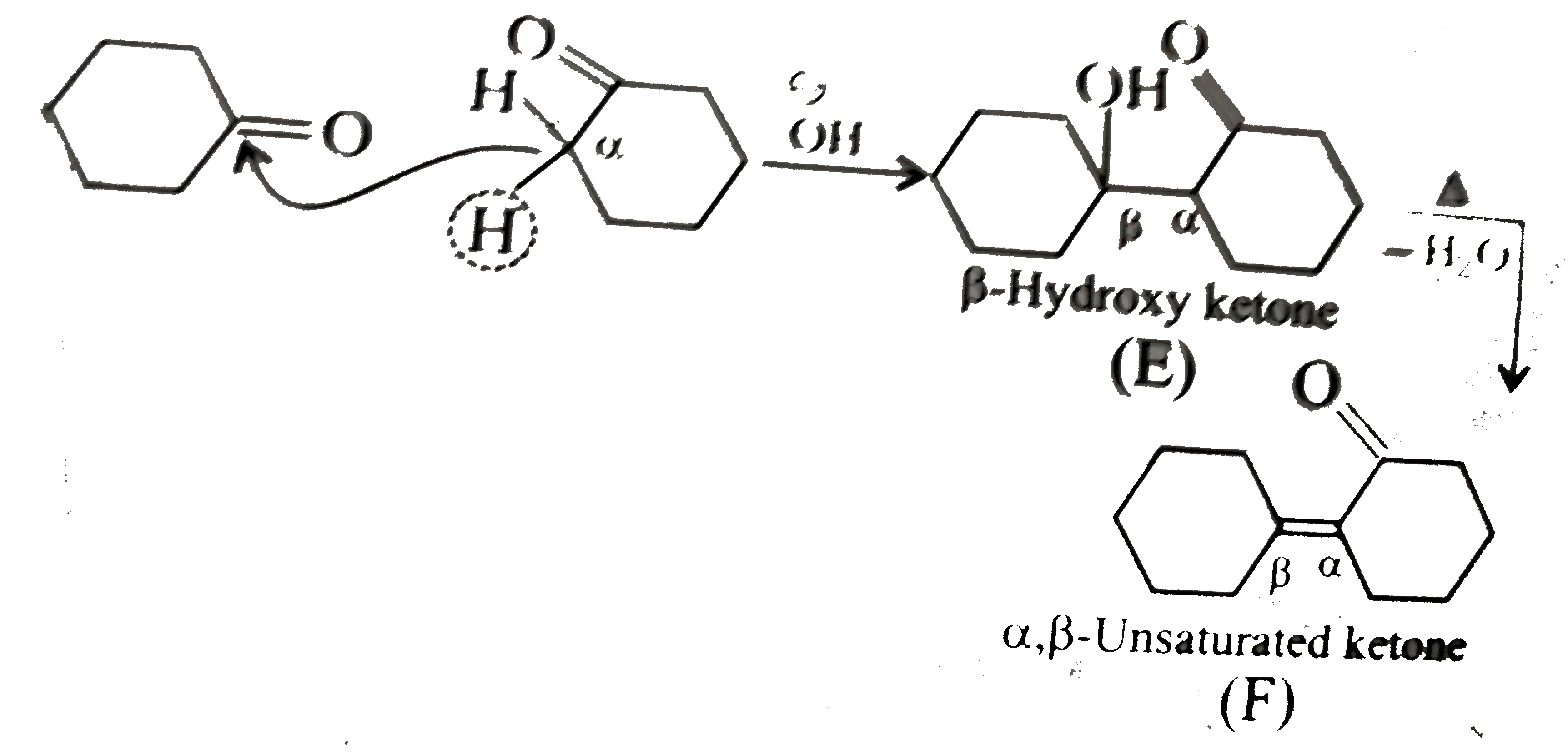
iv.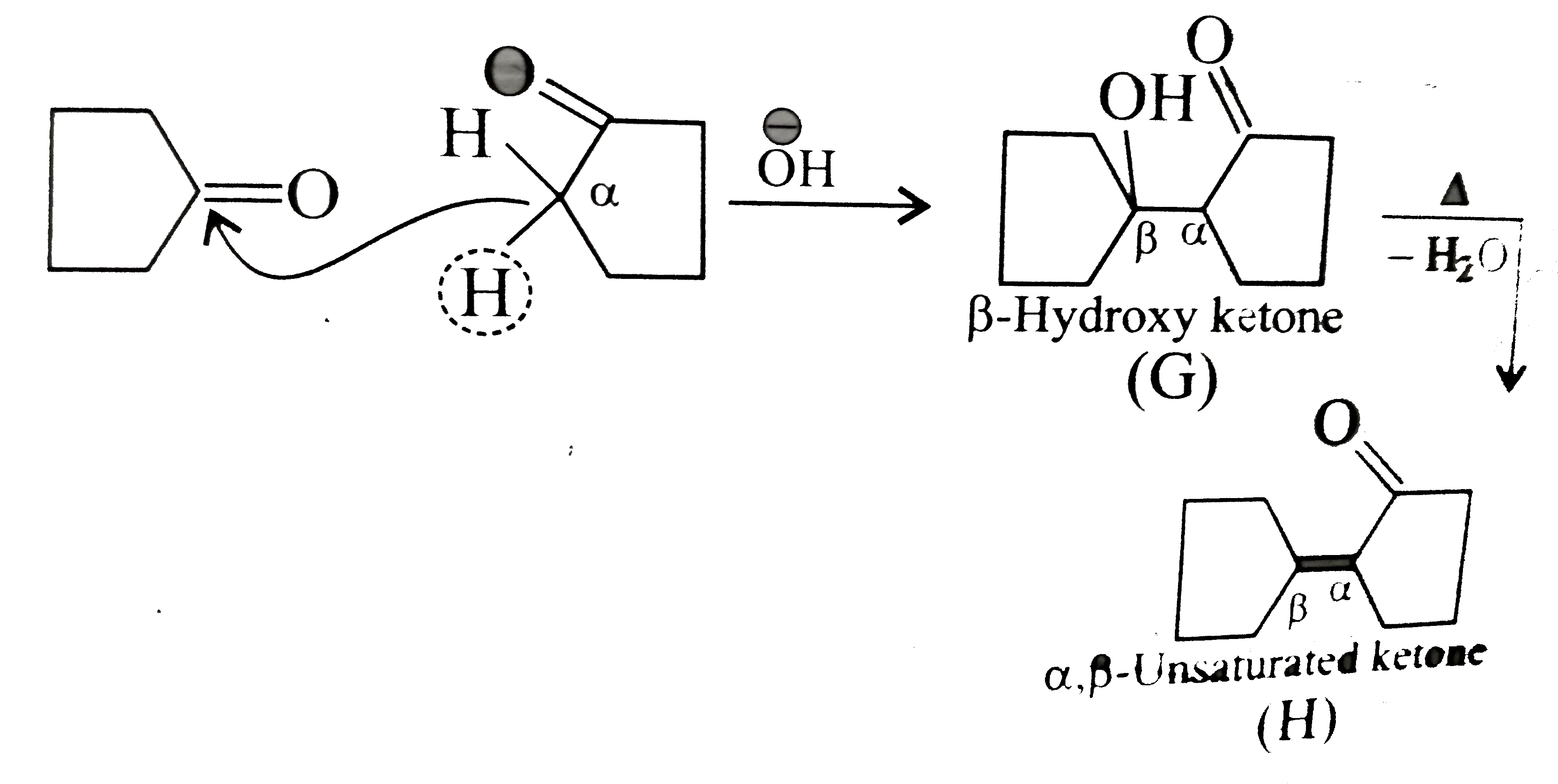
2. i. 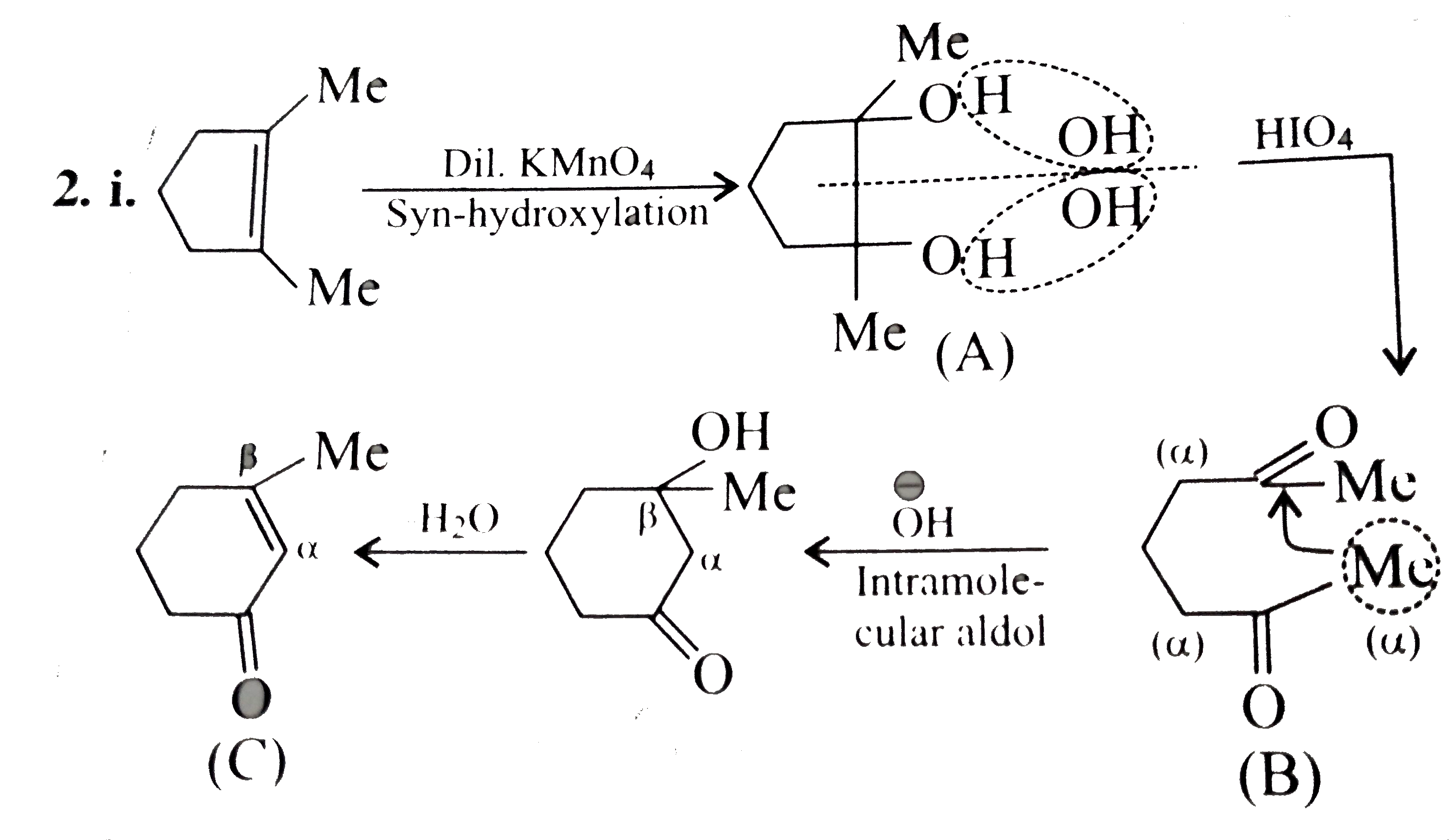
ii. 2 D.U. in A=(2nC+2)−nH2=16−122=2∘
Two D.U. in (A) suggest one (C=C) bond, cyclic compound obtained with base suggests ring in (A).

Proceed reverse:
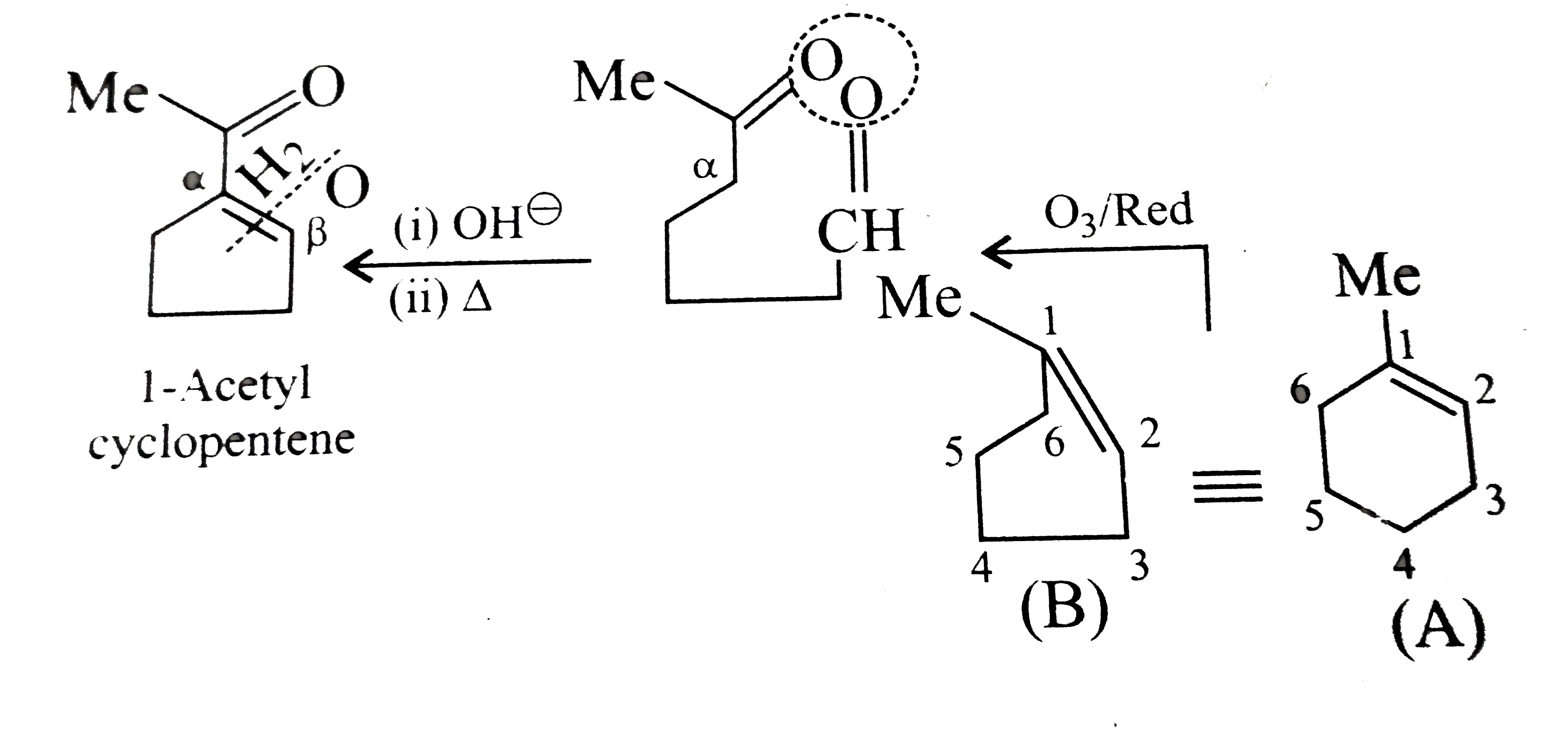
3.d.
Three self and three crossed aldol condensation products: Butan−2-one (unsymmetrical ketone) has two types of dissimilar α−H atoms (αMeCOCα'H2Me), and acetone (symmetrical ketone) has only one type of similar α−H atoms (αMeCOαMe).
4 a. 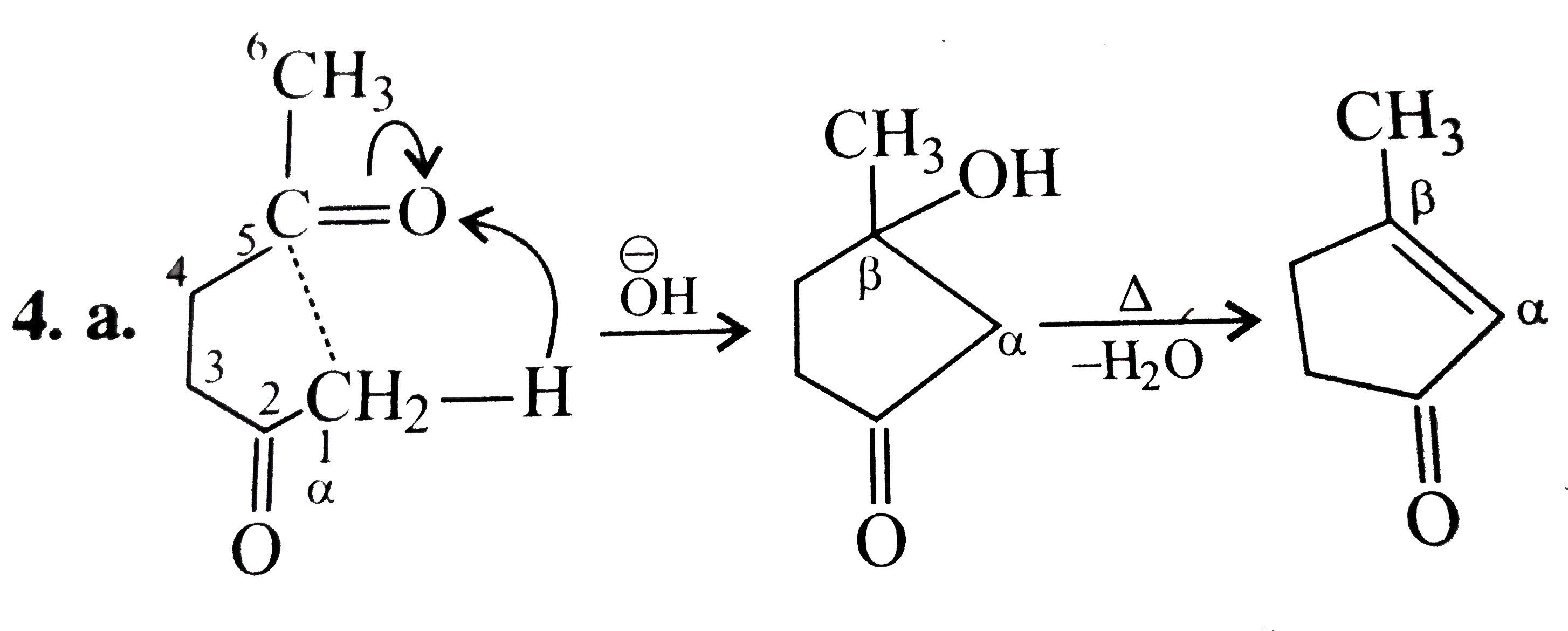
b. 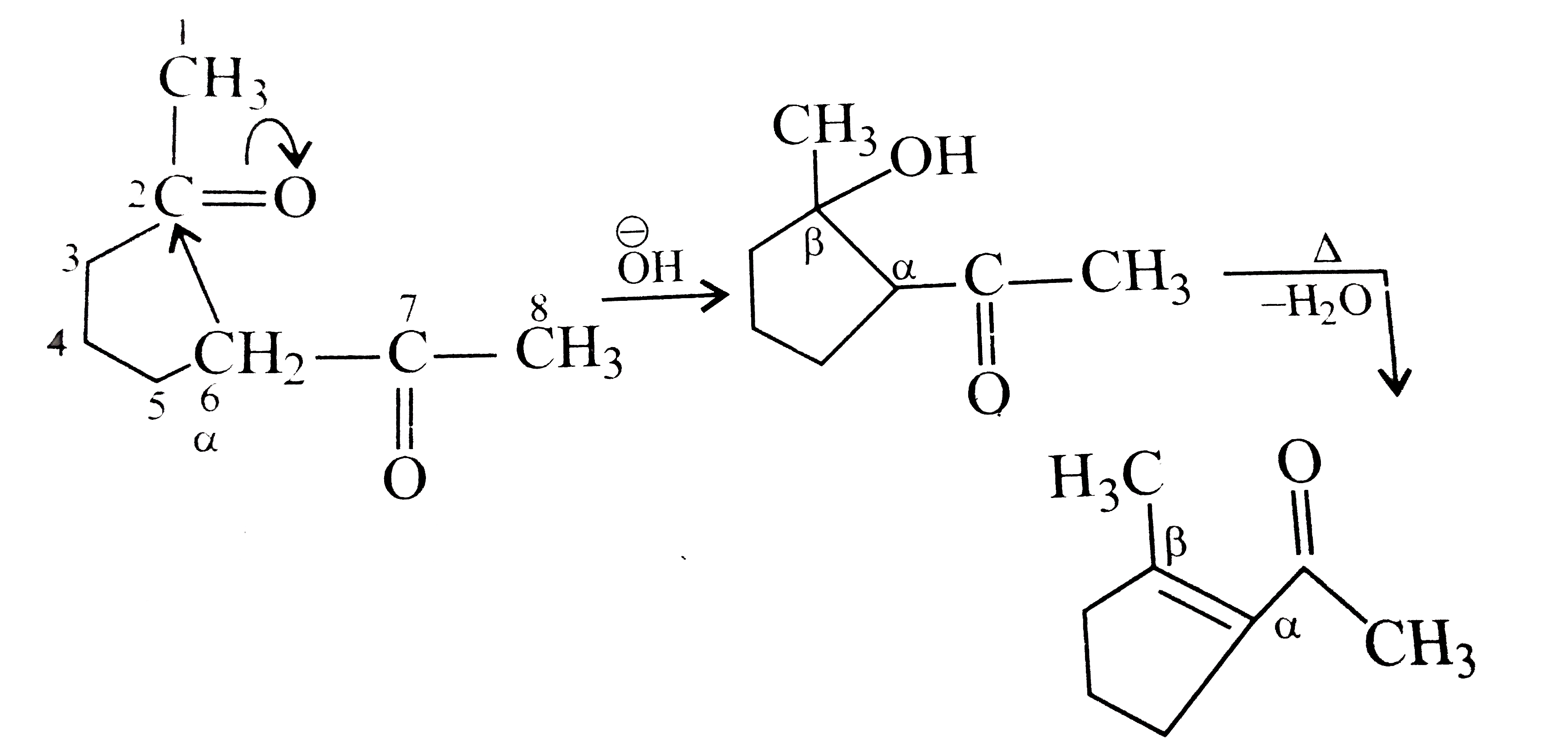
c.
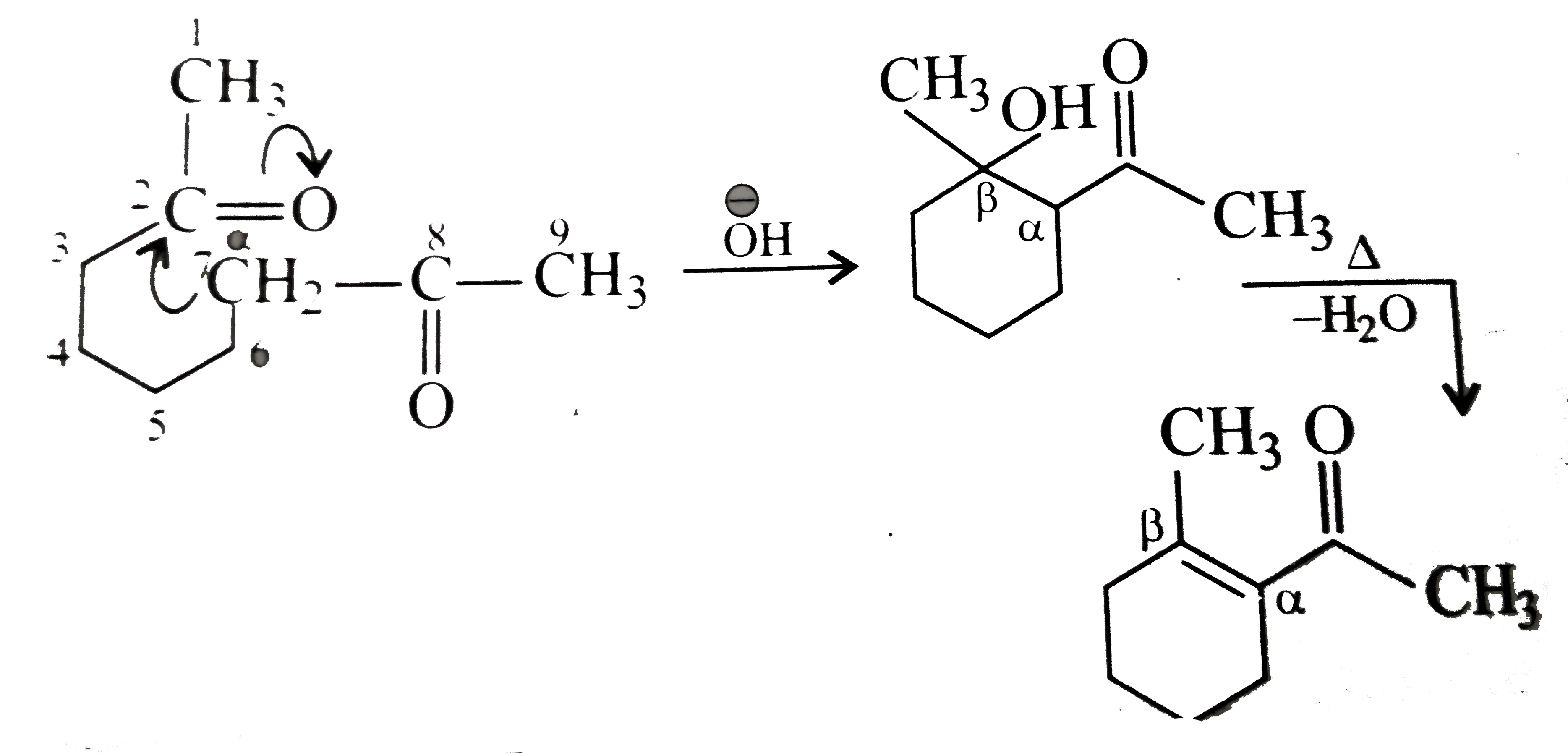
d. (CH3−CO−CH2−CO−CH3) merely forms the stable carbanion ⎛⎝CH3−CO−C..ΘH−COCH3⎞⎠ and does not react further. Carbanion does not add to C−4 because a strained four-membered ring be would be formed.
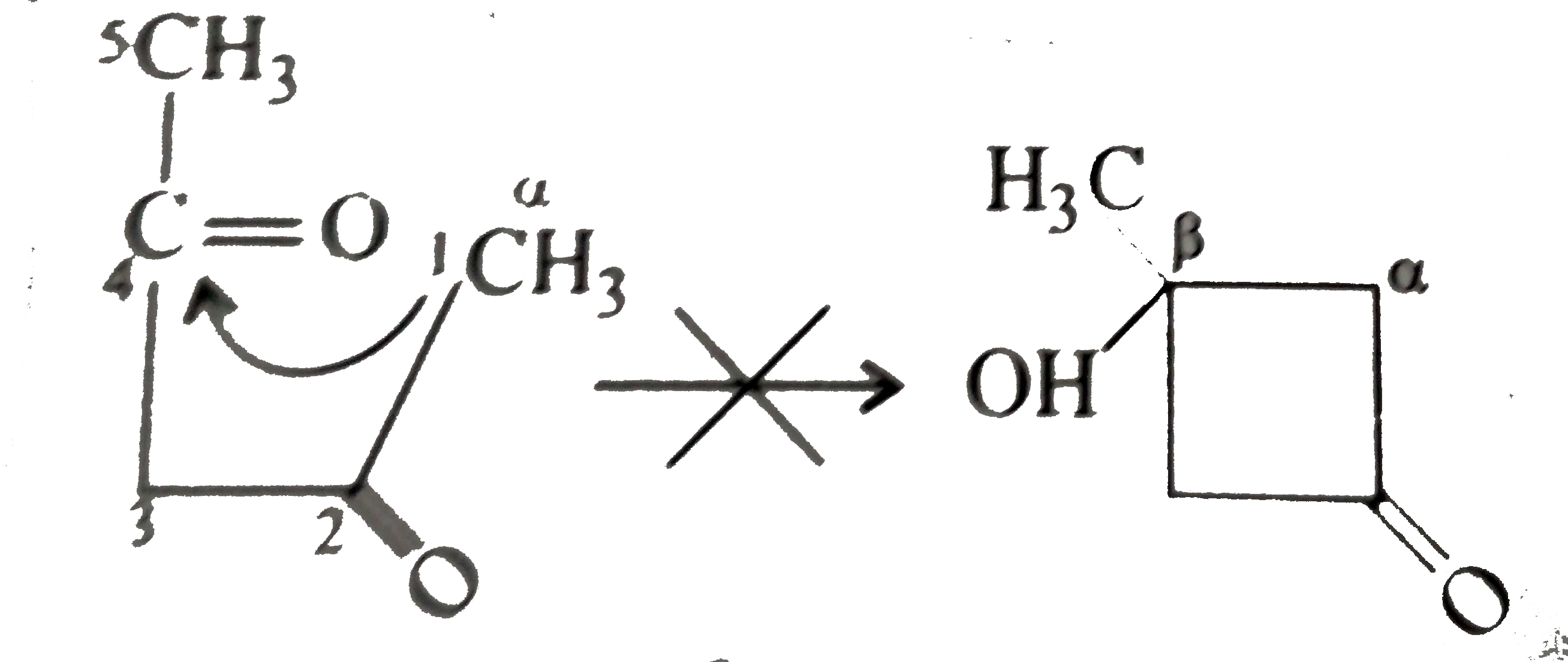
5. i.
iv. 
v. 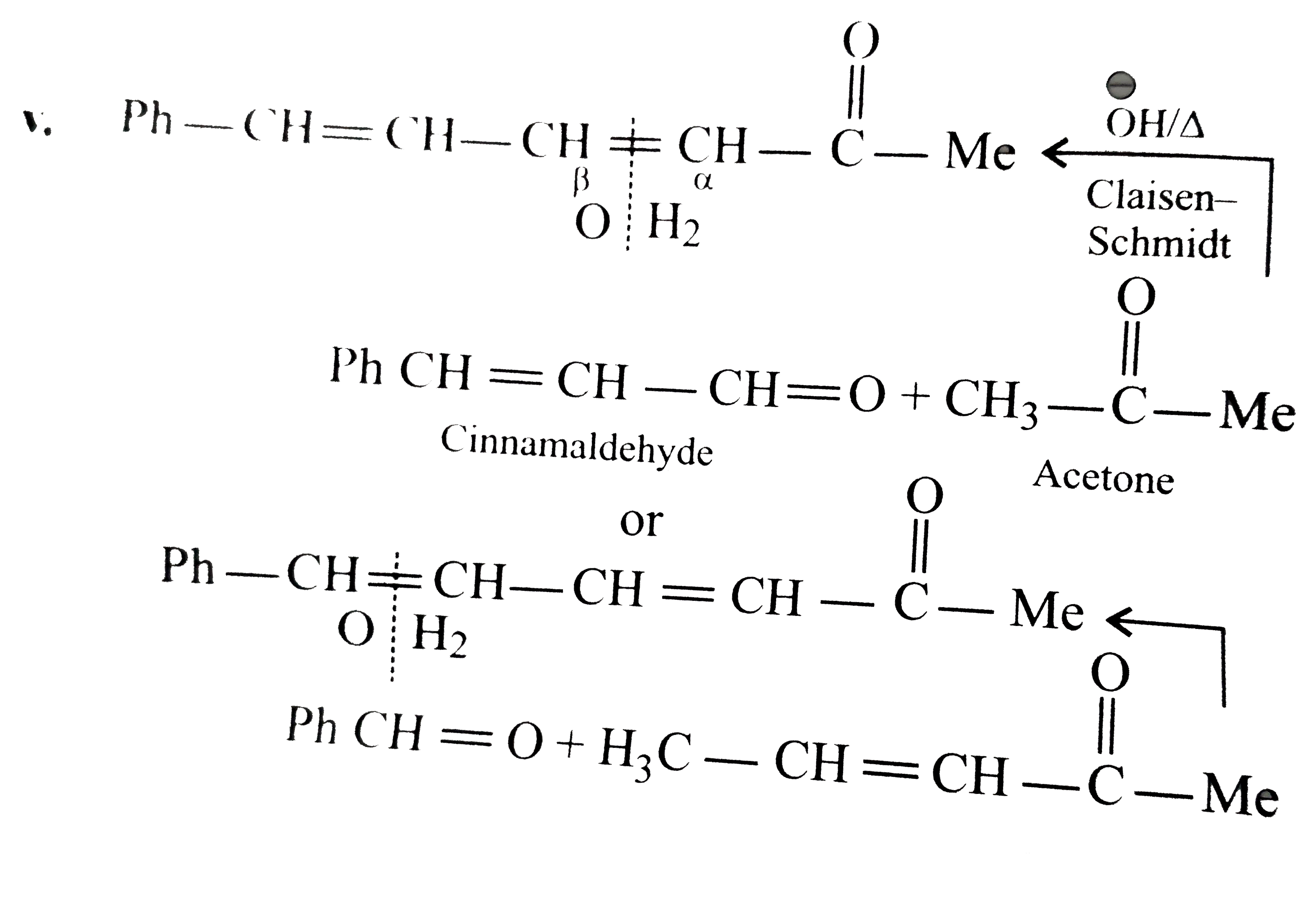
If the adol reaction of PhCH=O (I) with
CH3CH=CH−O∣∣C−Me(II) occurs, two different carbanions (enolate anions) can form
..ΘCHγ2CHβ=CHα−O∣∣C−Me(III) and
CH3CH=CH−O∣∣C−ΘCH2(α) (IV).
The carbanion (enolate anion) (III) is formed more easily than (IV). The carbanion (III) formed by the removal of γ−H of (II) with base is delocalised to O through the conjugated system giving carbanion enolate.
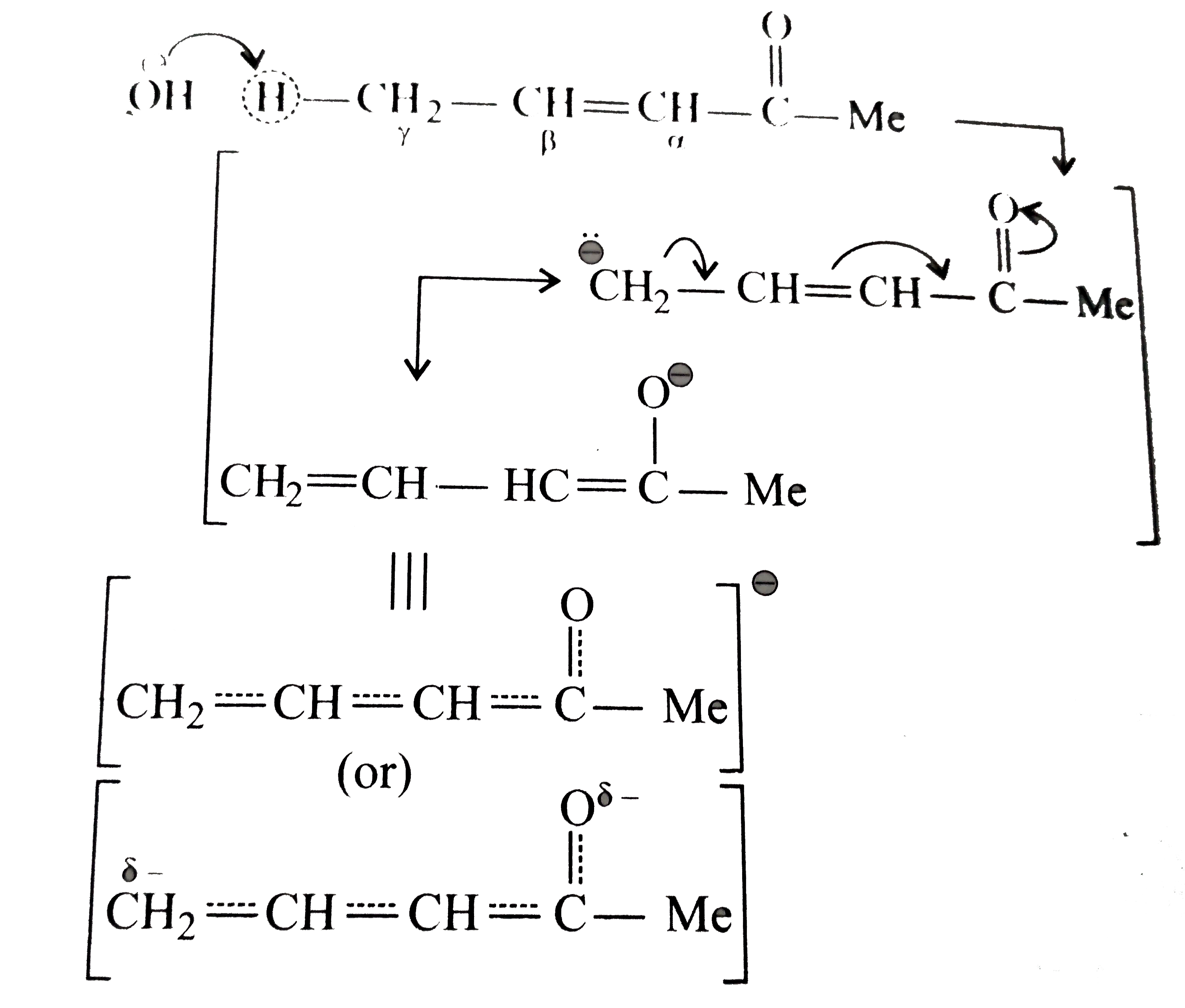
This anion (III) adds to the (C=O) of PhCH=O(I) to give δ-hydroxy alcohol which rapidly loses H2O to give the product that is triply conjugated and also is extended-conjugated with Ph group.

vi. 
vii. 
ix. 
The reactants of the products that cannot be synthesised by aldol condensation: (ii), (iii), and (vii).
ii. 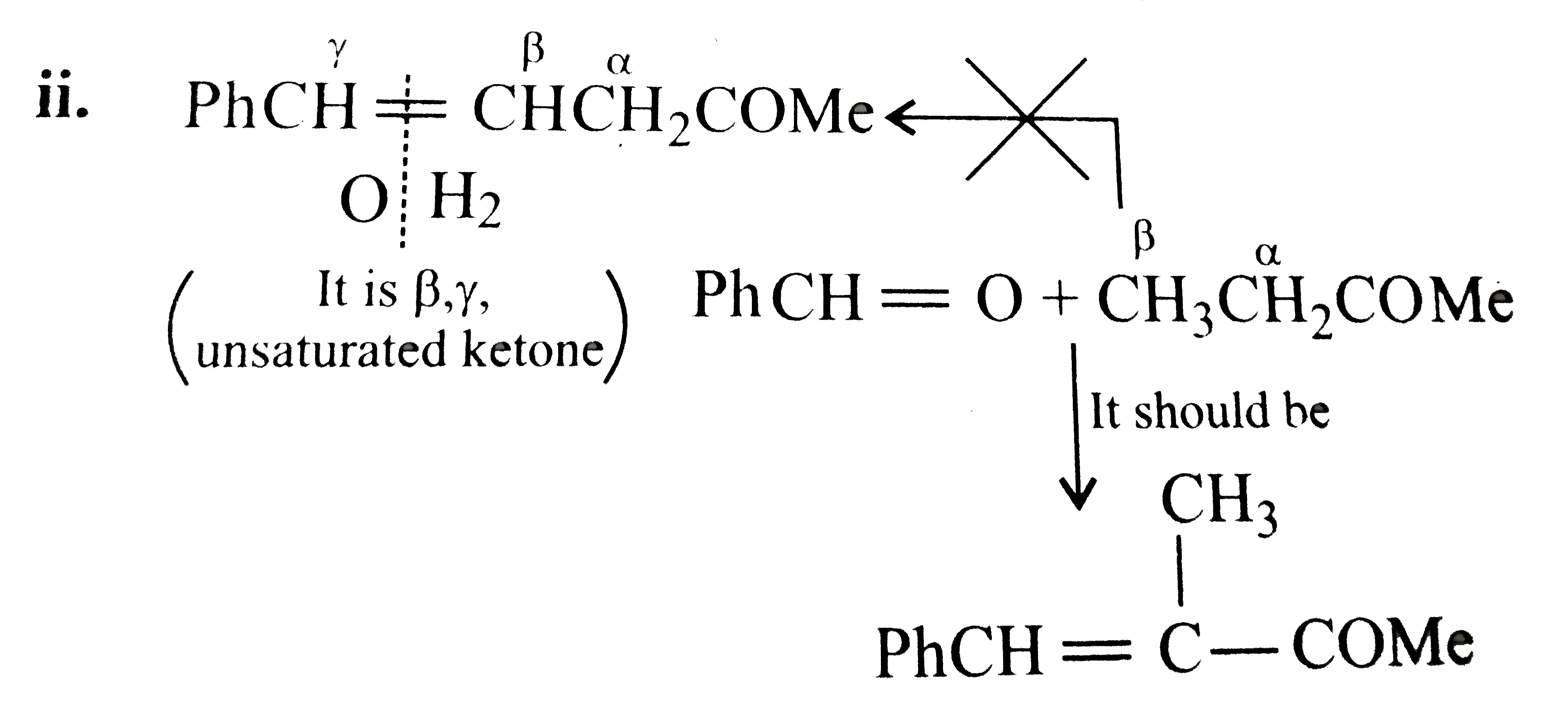
iii. 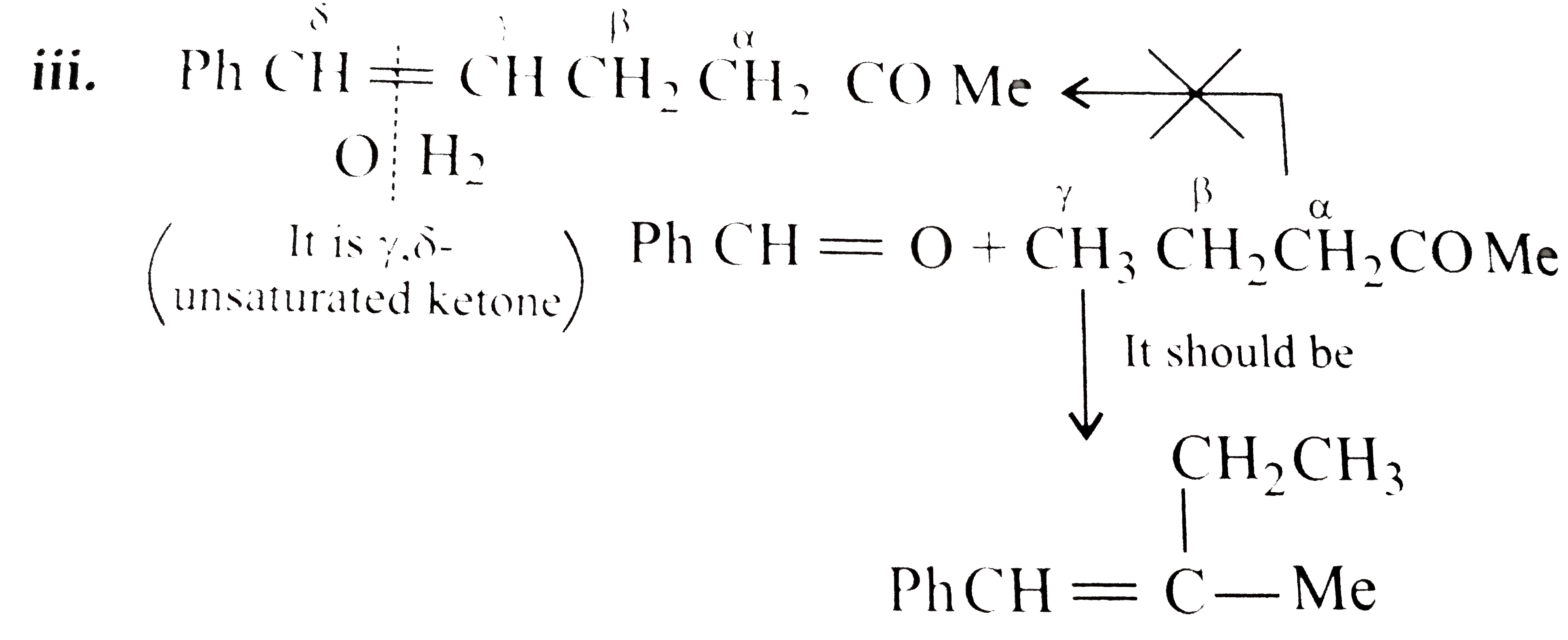
vii. 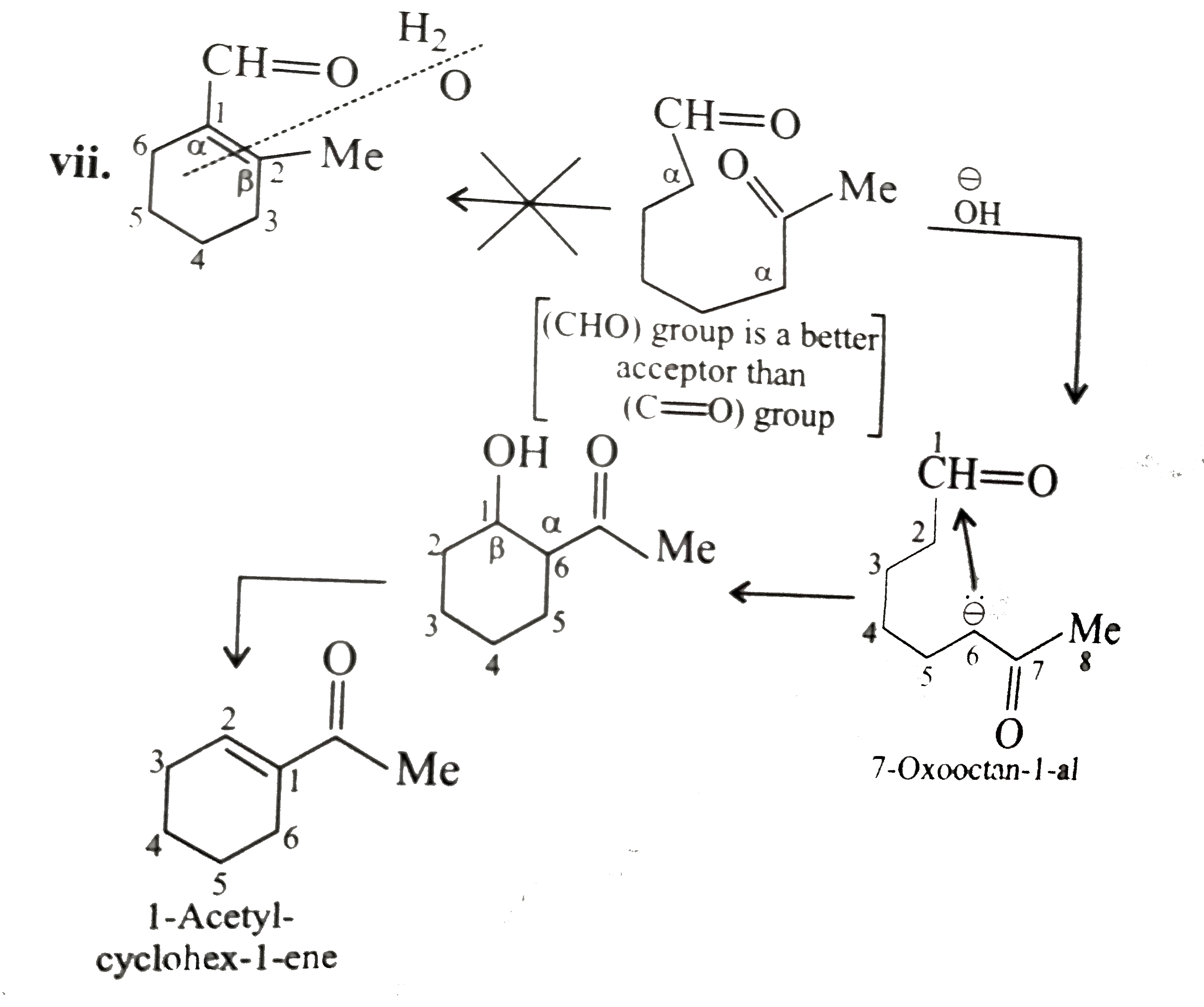
6. 
Topper's Solved these Questions
- ALIPHATIC AND AROMATIC ALDEHYDES AND KETONESBOOK - CENGAGE CHEMISTRYCHAPTER - ALIPHATIC AND AROMATIC ALDEHYDES AND KETONESEXERCISE - Solved Examples
13 Videos
- ALIPHATIC AND AROMATIC ALDEHYDES AND KETONESBOOK - CENGAGE CHEMISTRYCHAPTER - ALIPHATIC AND AROMATIC ALDEHYDES AND KETONESEXERCISE - Exercises Subjective
52 Videos
- ALCOHOL,PHENOL AND ETHERSBOOK - CENGAGE CHEMISTRYCHAPTER - ALCOHOL,PHENOL AND ETHERSEXERCISE - Archives Analytical And Descriptive
15 Videos
- AMINESBOOK - CENGAGE CHEMISTRYCHAPTER - AMINESEXERCISE - QUESTION BANK
1 Videos
Similar Questions
Write the structure of various isomers formed in the reaction given below.
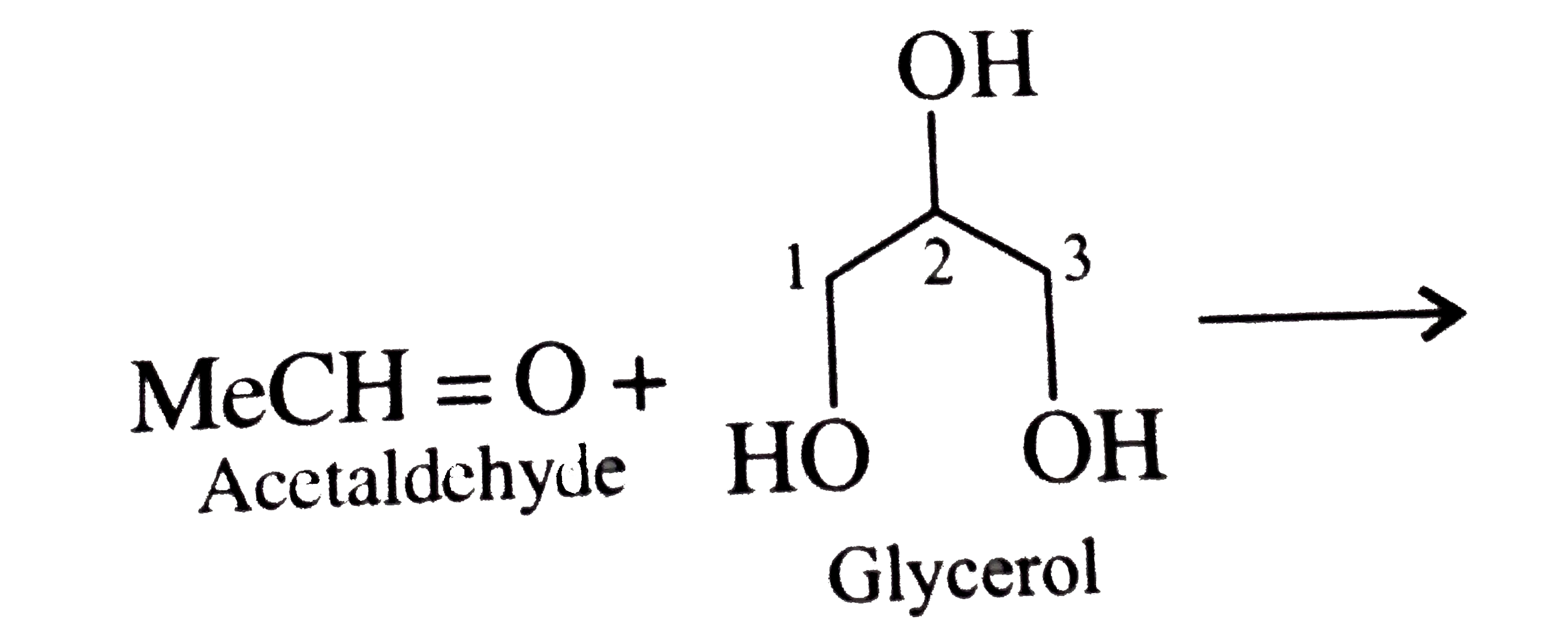
Gives six seperable isomers.
View SolutionComplete the following reaction:
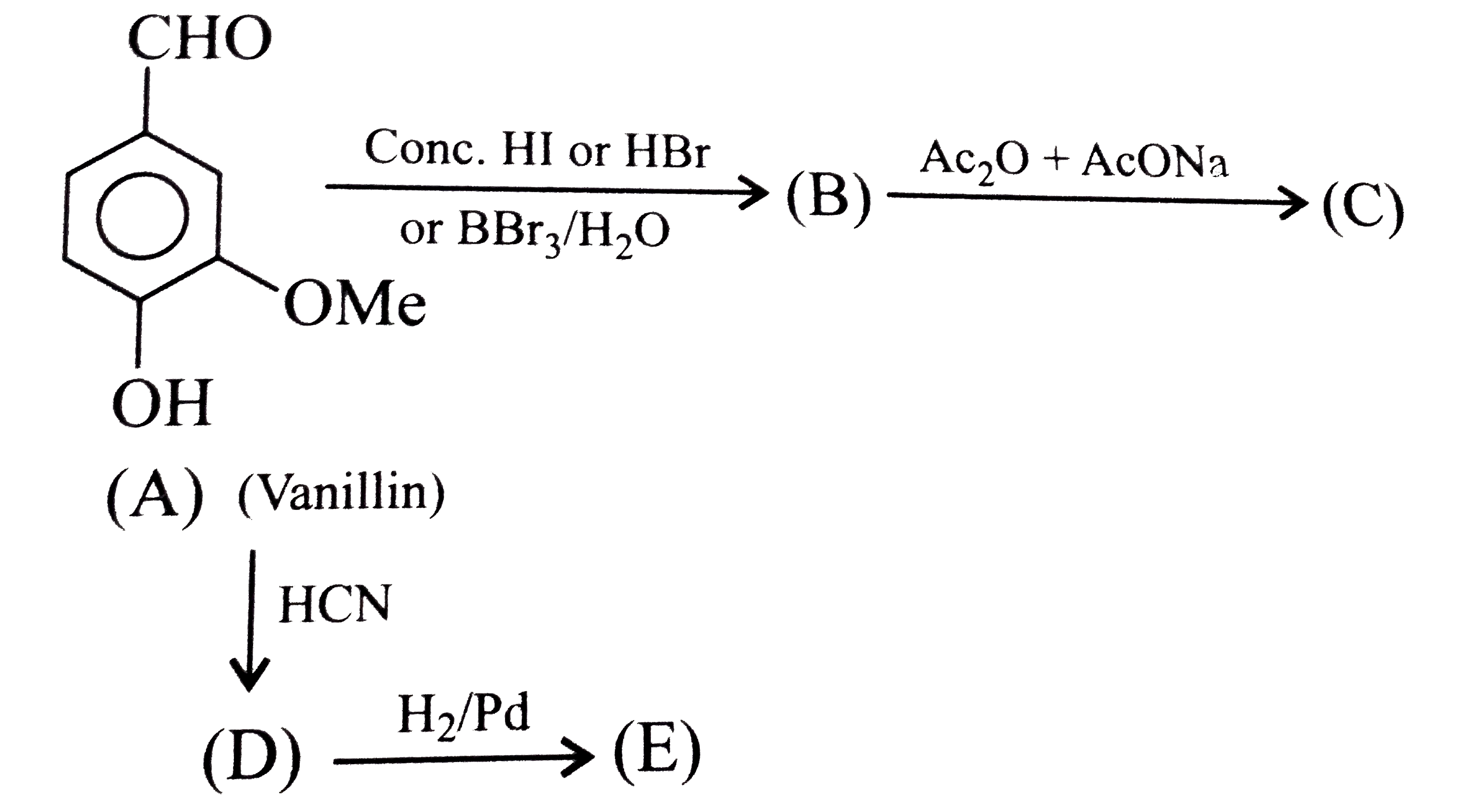
View SolutionAn alcohol A, when heated with conc. H2SO4 gives an alkene B. When B is bubbled through bromine water and the product obtained is dehydrohalogenated with exccess of sodamide, a new compound C is obtained. The compound C gives D when treated with warm dilute H2SO4 in the presence of HgSO4. D can also be obtained either byh oxidising A with KMnO4 or form acetic acid through its calcium salt. Identify A, B, C, and D.
View SolutionHow many of the following is/are not optically active amine?
(I) CH3NH2
(II) CH3NHCH3
(III) CH3CH2CH2N(CH3)C2H5
(IV) Secondary butylamine
View SolutionThe additon reaction of enol or enolate to the carbonyl function of aldehyde or ketone is known as aldol addition . The beta -hydroxyaldehyde or beta- hydroxyketone so obtained undergo dehydration in second step to produce a conjugated enone. The first part of reaction is an addition reaction and the second part is an elimination reaction. Carbonyl compound having alpha -hydrogen undergoes aldol condensation reaction . 2CH_(3)CH_(2)-overset(O)overset(||)C-Hunderset(Delta)overset(""^(Ө)OH)rarrCH_(3)CH_(2)CH=underset(CH_(3))underset(|)C-overset(O)overset(||)C-H Which of the following will give aldol condensation ?
View SolutionA hydrocarbon (A) of the formula , C_7H_12 on ozonolysis gives a compound (B) which undergoes aldol condensation giving 1-acetylcyclopentene. Identify (A) and (B).
View SolutionSteatement -I: Acrolein containing aldehyde group undergoes aldol condensation with alkali.
Statement -II The duoble bond breaks when treated with NaOH . H2C=CH−CHONaOH−−−→HCHO+CH3CHO
View SolutionIdentify (A) and (B) in the given sequence of reaction PhCH2CHOSeO2−−→(A)(i)conOH−−−−−−−−→(ii)H+(B)
View SolutionA hydrocarbon (A) of the formula C_(7)H_(12) on ozonolysis gives a compound (B) which undergo aldol condensation giving 1-acetylcyclopentene. Identify (A) and (B).
View SolutionAldehyde with atleast one α hydrogen undergo aldol condensation. Two molecles of same or different aldehydes take part in such condensation. Ketones under similar condition give ketol condensatio. These reactions is best done with Ba(OH2) . intramolecular aldol condensation is given by dialhydes, diketones aldol condensation is given by dialdehydes, diketones or keto aldehydes. The diketones should be 2,3, 2,6, 2,7 and 2,8 diketones. Intramolecular aldol condensation is the best method for prepartion of five and six memebered ring. For example:
CH3−O∣∣C−H+CH3−O∣∣C−NaOH(dil.)−−−−−−−→CH3−OH∣C∣H−CH2CHO
Cl2−CHO gives aldol aondensation.
View SolutionAldehyde with atleast one alpha hydrogen undergo aldol condensation. Two molecles of same or different aldehydes take part in such condensation. Ketones under similar condition give ketol condensatio. These reactions is best done with Ba(OH_(2)) . intramolecular aldol condensation is given by dialhydes, diketones aldol condensation is given by dialdehydes, diketones or keto aldehydes. The diketones should be 2,3, 2,6, 2,7 and 2,8 diketones. Intramolecular aldol condensation is the best method for prepartion of five and six memebered ring. For example: CH_(3)-overset(O)overset(||)C-H+CH_(3)-overset(O)overset(||)C-overset(NaOH(dil.))rarrCH_(3)-underset(H)underset(|)overset(OH)overset(|)C-CH_(2)CHO Cyclohexanone when treated with Ba(OH)_(2) gives, as a result of aldol condensation.
View SolutionAldehyde with atleast one α hydrogen undergo aldol condensation. Two molecles of same or different aldehydes take part in such condensation. Ketones under similar condition give ketol condensatio. These reactions is best done with Ba(OH2) . intramolecular aldol condensation is given by dialhydes, diketones aldol condensation is given by dialdehydes, diketones or keto aldehydes. The diketones should be 2,3, 2,6, 2,7 and 2,8 diketones. Intramolecular aldol condensation is the best method for prepartion of five and six memebered ring. For example:
CH3−O∣∣C−H+CH3−O∣∣C−NaOH(dil.)−−−−−−−→CH3−OH∣C∣H−CH2CHO
Mixture of HCHO and CH3CHO will not give aldol condensation.
View SolutionA compound A with molecular formula C_(10)H_(13)Cl give a white precipitate on adding silver nitrate solution. A on reacting with alcoholic KOH gives compound B as the main product, B on ozonolysis gives C and D. C gives cannizaro reaction but not aldol condensation D gives aldol condensation but not Cannizaro reaction A is
View SolutionAcetone undergoing Aldol condensation followed by dehydration gives
View SolutionWhich of the following undergoes condensation with NH_(2)OH but does not undergo aldol condensation ?
View Solution
